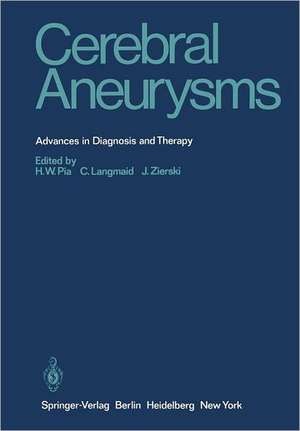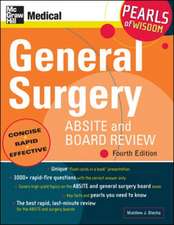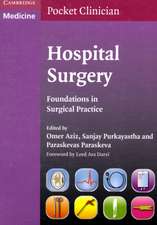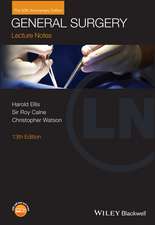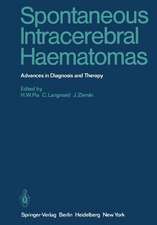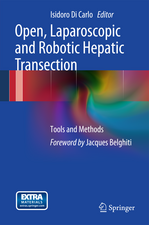Cerebral Aneurysms: Advances in Diagnosis and Therapy
Editat de H. W. Pia, C. Langmaid, J. Zierskien Limba Engleză Paperback – 14 noi 2011
Preț: 1108.51 lei
Preț vechi: 1166.84 lei
-5% Nou
Puncte Express: 1663
Preț estimativ în valută:
212.14€ • 230.35$ • 178.20£
212.14€ • 230.35$ • 178.20£
Carte tipărită la comandă
Livrare economică 22 aprilie-06 mai
Preluare comenzi: 021 569.72.76
Specificații
ISBN-13: 9783642671654
ISBN-10: 3642671659
Pagini: 488
Ilustrații: XIV, 468 p.
Dimensiuni: 170 x 244 x 26 mm
Greutate: 0.77 kg
Ediția:Softcover reprint of the original 1st ed. 1979
Editura: Springer Berlin, Heidelberg
Colecția Springer
Locul publicării:Berlin, Heidelberg, Germany
ISBN-10: 3642671659
Pagini: 488
Ilustrații: XIV, 468 p.
Dimensiuni: 170 x 244 x 26 mm
Greutate: 0.77 kg
Ediția:Softcover reprint of the original 1st ed. 1979
Editura: Springer Berlin, Heidelberg
Colecția Springer
Locul publicării:Berlin, Heidelberg, Germany
Public țintă
ResearchDescriere
Microsurgery has brought about important changes and progress in the treatment of cere bral aneurysms in recent years. Only 12 years ago McKissock, one of the most experienced surgeons in the treatment of aneurysms pompared the results of operative and nonoperative treatment. He found that mortality and morbidity of cerebral aneurysms was not significantly affected by whether the patients have been operated upon or not. This view is held by many neursurgeons, and was confirmed by results of the Co-operative Study in 1969. In the review on treatment of aneurysms in Progress in Neurological Surgery in 1969, techniques such as encasement with plastic compounds, piloinjection, stereotactic copper or electric thrombosis and metallic thrombosis and profound hypothermia in anaesthesia were listed. In general, these techniques now seem to be of little more than historical interest. Progress in recent yeats has been so enormous that one may perhaps gain the impreSSion that the main problems in the treatment of aneurysms have been solved and that there are no more to be surmounted. This is dangerous and complacent thinking, such as Lord Moynihan indulged in during the thirties. For this reason we thought that the time had come to assemble a group of experts who could discuss the various unsolved and contro versial problems of aneurysm surgery in the friendly and relaxed atmosphere of a "work shop".
Cuprins
1 History of Aneurysm Surgery.- 2 Morphology and Aetiology.- 2.1 Pathology and Aetiology of Intracranial Aneurysms.- 2.2 Factors Related to Growth, Rupture and Spontaneous Healing of Cerebral Aneurysms.- 2.3 Origin, Rupture and Growth of Cerebral Aneurysms: a Clinicopathological Study.- 2.4 Discussion.- 3 Classification.- 3.1 Introduction.- 3.2 Extracranial Internal Carotid Aneurysms.- 3.2.1 Aneurysms of the Cervical Internal Carotid Artery.- 3.2.2 Internal Carotid Aneurysms Arising in the Carotid Canal.- 3.2.3 Anatomy of the Cavernous Sinus.- 3.2.4 Intracavernous Carotid Aneurysm Jean Brihaye, Brussels.- 3.2.5 Aneurysms of the “Cavernous Sinus”.- 3.2.6 Discussion.- 3.3 Intracranial Internal Carotid Artery Aneurysms.- 3.3.1 Internal Carotid Ophthalmic Aneurysms.- 3.3.2 Aneurysms of the Internal Carotid (ICA) Ophthalmic Artery (OA) Junction.- 3.3.3 Aneurysms of the Internal Carotid Artery (ICA) and Posterior Communicating Artery (PCoA) and Anterior Choroidal Artery (AChA) Region.- 3.3.4 Internal Carotid Artery Bifurcation Aneurysms.- 3.3.5 Aneurysms of Internal Carotid Artery Bifurcation.- 3.3.6 Discussion.- 3.4 Aneurysms of the Anterior Cerebral Artery.- 3.5 Aneurysms of the Middle Cerebral Artery.- 3.5.1 Aneurysms of the Middle Cerebral Artery — Discussion.- 3.6 Aneurysms of the Vertebral Artery.- 3.7 Aneurysms of the Basilar Artery.- 3.8 Aneurysms of the Posterior Cerebral Artery.- 4 Distribution of Cerebral Aneurysms.- 5 Clinical Pathology and Pathophysiology.- 5.1 Noninvasive Regional Cerebral Blood Flow Measurement in Subarachnoid Haemorrhage.- 5.2 Cerebral Blood Flow in Subarachnoid Haemorrhage.- 5.3 Subarachnoid Haemorrhage and Cerebral Vasospasm.- 5.4 Cerebral Vasospasm: Prediction, Prevention and Protection.- 5.5 Hydrocephalus Following Subarachnoid Haemorrhage.- 5.6 Discussion.- 6 Neuroradiological Diagnosis.- 6.1 Cerebral Angiography.- 6.1.1 Classical Angiography.- 6.1.2 Magnification and Tomography.- 6.1.3 Intraoperative Angiography.- 6.1.4 Discussion.- 6.2 Computer Tomography.- 6.2.1 CAT Findings in Cerebral Aneurysms and Subarachnoid Haemorrhage.- 6.2.2 Value of CAT in Pre- and Postoperative Management of Cerebral Aneurysms.- 6.2.3 Discussion.- 7 Conservative Treatment.- 7.1 Preoperative Treatment of Intracranial Aneurysms.- 7.2 Preoperative Management of Ruptured Intracranial Aneurysms with Antifibrinolytic Treatment.- 7.3 Discussion.- 8 Operative Treatment.- 8.1 General Therapeutic Problems.- 8.1.1 Grading and Timing of the Operation on Cerebral Aneurysms.- 8.1.2 Indication and Timing of Operation and Vasospasm.- 8.1.3 Discussion.- 8.1.4 Deliberate Hypotension with Sodium Nitroprusside in Neuroanesthesia.- 8.1.5 Protective Vascular Mechanisms of the Brain During Profound Arterial Hypotension.- 8.1.6 Discussion.- 8.2 Special Therapeutic Problems.- 8.2.1 Internal Carotid Artery Aneurysms — Cavernous Sinus Aneurysms.- 8.2.1.1 Surgical Approach to Cavernous Sinus Aneurysms.- 8.2.1.2 Treatment of Carotid-Cavernous Fistulae and Arterial Aneurysms by Detachable Balloon.- 8.2.1.3 Post-traumatic Fistulae Between the Internal Carotid Artery and the Cavernous Sinus.- 8.2.1.4 Discussion.- 8.2.2 Internal Carotid Ophthalmic Artery Aneurysms.- 8.2.2.1 Treatment and Results for Carotid Ophthalmic Aneurysms.- 8.2.2.2 Discussion.- 8.2.3 Internal Carotid Posterior Communicating Anterior Choroidal Region Aneurysms.- 8.2.3.1 Microsurgical Treatment.- 8.2.3.2 Technical Aspects.- 8.2.4 Internal Carotid Artery Bifurcation Aneurysms.- 8.2.4.1 Special Therapeutic Problems.- 8.2.5 Anterior Cerebral Artery Aneurysms.- 8.2.5.1 Operative Treatment.- 8.2.5.2 Discussion.- 8.2.6 Middle Cerebral Artery Aneurysms.- 8.2.6.1 Treatment of Saccular Aneurysms.- 8.2.7 Addendum: Classification of Vertebrobasilar Aneurysms.- 8.2.8 Vertebral Artery Aneurysms.- 8.2.8.1 Operative Treatment.- 8.2.9 Basilar Artery Aneurysms.- 8.2.9.1 Surgery.- 8.2.9.2 Surgery of Upper Basilar Artery Aneurysms. Experience with 11 Cases.- 8.2.9.3 Microsurgical Treatment of Vertebrobasilar Aneurysms.- 8.2.9.4 Transoral-Transclival Approach.- 8.2.9.5 Discussion.- 8.2.10 Posterior Cerebral Artery Aneurysms.- 8.2.10.1 Operative Treatment.- 8.3 Giant Cerebral Aneurysms.- 8.3.1 Problems in Treatment.- 8.3.2 Discussion.- 8.3.2.1 Management.- 8.3.2.2 Results.- 8.3.2.3 Serpiginious Giant Aneurysm of the Internal Carotid Artery in a Young Female.- 8.3.2.4 General Discussion.- 8.4 Multiple Aneurysms.- 8.4.1 Treatment.- 8.4.2 Discussion.- 8.5 Traumatic Aneurysms.- 8.5.1 Survey.- 8.5.2 Development of Traumatic True Saccular Aneurysms.- 8.6 Aneurysms of Childhood.- 8.7 Special Technical Problems.- 8.7.1 Surgery of Intracranial Aneurysms — To Clip or not to Clip the Neck of the Sac.- 8.7.2 Slipping Clip.- 8.7.3 Form of Clips.- 8.7.4 Coagulation of Aneurysms.- 8.7.5 Discussion.- 8.7.6 Temporary Clipping — Prolongation of the Time of Occlusion by Mannitol.- 8.7.7 Trapping Techniques.- 8.7.8 Wrapping Technique — Present Place.- 8.7.8.1 Discussion.- 8.7.9 Cervical Carotid Artery Ligation.- 8.7.9.1 Discussion.- 8.8 Operative Treatment of Complications.- 8.8.1 Intraoperative Aneurysmal Rupture and Reduction by Coagulation of the Sac.- 8.8.1.1 Discussion.- 8.8.2 Intracerebral Haematomas.- 8.8.2.1 Discussion.- 9 Prognosis of Operative Treatment.- 9.1 A 25 Year Study.- 9.2 Summary.- 9.3 Discussion.- 9.3.1 Prognosis of 1000 Pure Saccular Aneurysms Operated Upon.- 9.3.2 Results and Discussion.- 9.3.3 Statistics of La Pitié Material.- 9.3.4 Results.- 9.3.5 Personal Experiences.- 9.3.6 Material of Institute of Neurology, London.- 10 Final Comments.- 11 References.- 12 Subject Index.
